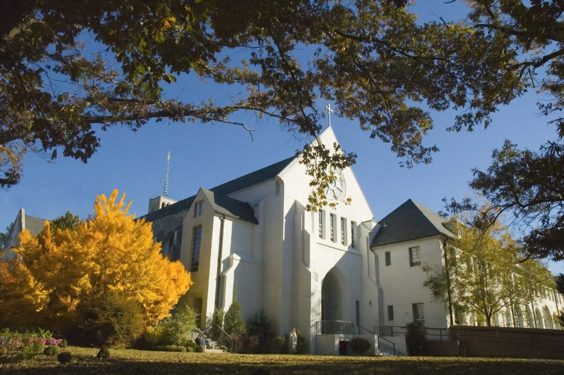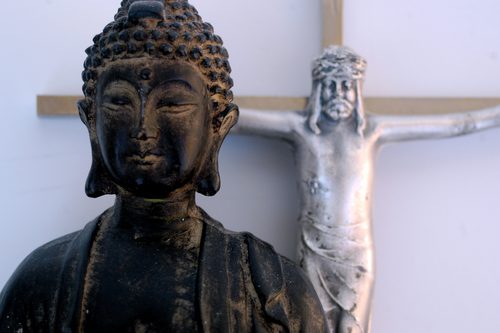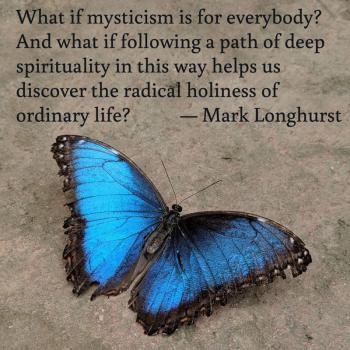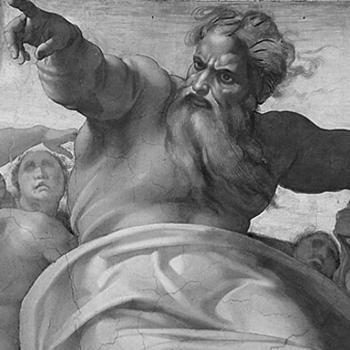
Autumn in Georgia is a mild and lovely season, marked by golden sunlight, cool mornings and temperate days. And even if we can’t boast the shock of gorgeous color that grace the trees in states like Vermont or Minnesota, we have enough yellow poplars and white oaks and other trees to remind the Georgia Pines that winter is coming. The first year of my formation as a Lay Cistercian, the colors at the monastery were particularly vivid — not only the native trees, but two ginkgoes that stood on either side of a short flight of steps leading from the church to the guesthouse. As the yellow ginkgo leaves fell, it seemed like the sidewalk had been carpeted in a luminous gold.
But the beauty of nature is not all that I remember from that fall. One conversation from my novice class particularly stands out. We were reading André Louf’s The Cistercian Way. Although written for monks, the book offers insight into the spirituality and life of contemplative monastics that anyone might find inspiring. I certainly was enjoying both the book and the class and looked forward to our monthly gathering where, with my eleven fellow-novices, I would reflect on the unique gifts of the Cistercian tradition and their meaning for my life.
Our topic on this particular fall day was asceticism, and one passage from Dom André’s book came up for discussion: “A genuine interior life can grow only through the body. This is true of every system of spiritual development inside or outside the Christian religion.”[i]
In our conversation, one of my fellow novices related this passage to her daily practice of yoga. Immediately, another woman in the class expressed her discomfort with the idea that a Catholic, or indeed any Christian, could ever engage in yoga, since it originated within Hinduism. “Blending un-Christian practices with Christianity just strikes me as being disobedient to God. What do you think?” she asked, directing her inquiry to our instructor — who was a substitute for our regular novice master that month — a grandmotherly woman who had been one of the first Lay Cistercians at our monastery, and was well-known for her gentle, but strictly orthodox, expression of faith. I held my breath, concerned that her answer would either upset me, or the woman who asked the question.
“Here’s how I see it,” the teacher began. “Some Christians discern a call to explore the teachings and practices of other faiths. That’s certainly not true for all Christians,” she hastened to add. “I certainly don’t have any sense of being called in that way. But some do. Now, if you don’t have a call to learn about other faiths, then by all means, don’t go there. But if you do, then you should be faithful to your call. And all of us need to learn to respect the fact that different people express their faith in different ways.”
Humbled by her gently-stated wisdom, I realized — perhaps for the first time — that my spiritual calling involved two dimensions: a calling to deep loyalty and fidelity to my faith as a contemplative Christian, along with a simultaneous calling to learn of the wisdom and beauty of other wisdom traditions. I would say “all” wisdom traditions, although I do not feel drawn to all equally: I sense a greater affinity with Buddhism and Neo paganismthan with Sikhism or Baha’i. But even the paths I am not intuitively drawn to still interest me, and when I meet a Sikh or a Baha’i, I’m as interested in their stories as in the stories of any Catholic or Presbyterian I encounter.
So — called to deep fidelity to one path, and deep engagement with interspirituality and interfaith dialogue. Is such a “dual calling” even possible? Some might question it, but, to borrow the words attributed to Huston Smith when a woman objected to him calling himself a Zen Catholic: “here I am.”
A Long and Meandering Path
My journey to interspirituality has taken a long and meandering path. I think it started with rock and roll; specifically, with the 70’s prog-rock band Yes and their 1973 album Tales from Topographic Oceans, which many critics hate but I happen to think is their magnum opus. It’s a concept album, based on an idea that lead singer Jon Anderson found in the book Autobiography of a Yogi by Paramahansa Yogananda. Because I loved Yes and loved the album, I bought the book and devoured it. And an entire world opened up to me: the world of spirituality outside of Christianity. I was a Protestant teenager in a small city in the south; “interfaith” to me meant being nice to the Jewish kids in my school. I had learned about other religions in my social studies class, but Yogananda’s book was my first foray into the spirituality of other faiths, seen from the inside. Reading it did not make me want to give up being a Christian or become a Hindu. It just made me realize that there was something deeper than just the external observance of this or that religion could provide.
A year or two later a friend gave me a copy of Evelyn Underhill’s Mysticism, primarily about Christian mysticism — and it opened up the world of deep Christian spirituality for me in a manner similar to how Yogananda’s book introduced me to the idea of world mysticism. About this time I went off to college, and being both geeky and an introvert, I found that books became my spiritual companions, friends, and confidants. On the Christian side, I was reading folks like Morton Kelsey, C. S. Lewis, Evelyn Underhill, and Thomas Merton; on the interfaith side, Alan Watts, Carlos Castaneda, Starhawk, and Baba Ram Dass. And then there was Matthew Fox, who was a Christian priest but kept talking about other faiths; for that Matter, Merton in his later writings did the same. In graduate school I discovered the Shalem Institute, where I studied Christian meditation, while also encountering the work of the Tibetan Buddhist Tarthang Tulku.
More twists and turns ensued. Drawn to Neopaganism, I alternately tried being a type of hybrid “Episcopagan,” — since I was an Anglican at the time — and turning my back on Christianity to study (and write about) Paganism exclusively. But despite the many flaws of the institutional church, the beauty and splendor of Christianity, especially in its mystical and contemplative expressions, would not let me go. My love for Jesus Christ and his teachings, and the wisdom of his followers like Julian of Norwich and Meister Eckhart and Teresa of Avila and John of the Cross, simply was knit into my spiritual DNA. I soon came to realize that I could no more stop being a Christian than a gay person going through “ex-gay therapy” can stop experiencing same-sex attraction. But the other dimension of my spiritual identity retains just as strong a hold on me. Even after I returned to Christian identity and practice after my period of exploring Neopaganism, I continued to yearn for spiritual nurture that I could only find in non-Christian contexts: whether that meant studying meditation at the Shambhala Center, finding meaning in the myths and legends of the pre-Christian Celts, or participating in interfaith meditation circles such as are held in Atlanta every Sunday night.
I feel vulnerable as I write these words, for I know that plenty of folks on both sides of my spiritual identity will find much to reject in who I am. On the Christian side there are those, like my friend at the monastery, who see Christians “dabbling” in Buddhism or Sufism or Neopaganism as a type of spiritual adultery; while on the other side is the entire “spiritual but not religious” community, who find meaning and purpose in a self-directed program of mystical inquiry — but who chafe at the boundaries and commitments that any one religious tradition might want to impose upon them. I stand in the middle, seeking a spirituality that is radically faithful to the Christian tradition while radically open to wisdom and truth wherever it may be found. And while I may have my critics, thankfully I am not alone.
The Rock and the River
In the 1960s the Anglican theologian Martin Thornton wrote a book called The Rock and the River about Christianity and what he called “modern thought” (but today would be considered post-modern). Writing at the height of the “death of God” controversy, Thornton attempted to make an irenic statement: Christians can hold on to the truths of their faith while being fully engaged with the concerns of the present age. He compared “traditional (Christian) spirituality” to a rock — stable, unchanging, firm. Meanwhile, the kaleidoscopic flux of contemporary philosophy he likened to a river, ever changing, dynamic, endlessly flowing. Thornton’s basic argument: that while some might insist that the rock is a good thing and the river something dangerous, or alternatively, that the river is “current” while the rock hopelessly ancient; Christian spirituality at its best involves a dynamic synthesis between the unchanging rock and the dynamic river. Citing Psalm 78:20 (“he struck the rock so that water gushed out and torrents overflowed”), Thornton suggests that a truly Biblical understanding of faith encompasses both that which is immutable and that which is always evolving.
It’s not the best of analogies (what immediately comes to my mind: most streams teem with life while a stone is basically inorganic), but it does point to the tension between what the Benedictine tradition calls stability — a commitment to a particular place, a particular community, and a particular set of values — and the reality that, as Jefferson Airplane once bluntly sang, “life is change.” As a spiritual virtue, stability suggests that change is something we should resist, avoid, or deny. From the Catechism of the Catholic Church to the latest evangelical statement about Biblical inerrancy, much Christian thought is geared toward a strict conservatism: if the Gospel is true, one mark of its truth is that it never varies. But while that might work in the abstract realm of pure thought, in the messy reality of material life, the human experience is all about change.
Heraclitus observed that one cannot step in the same river twice; and likewise, a core principle of Buddhism is the sheer impermanence of all things. But even the Benedictine tradition with its loyalty to stability has room for the changeableness of things. St. Benedict insisted that his monks practice hospitality; indeed, they were to welcome strangers and guests with the same honor and respect they would offer to Christ himself. As anyone who has ever offered hospitality to houseguests knows, welcoming the stranger into one’s home leads to a kind of small-scale chaos: having visitors will disrupt your routines, your space, and perhaps even your values. Granted, healthy hospitality must include boundaries; you are welcome to stay in my home, but you don’t get to take my belongings with you when you leave. Yet isn’t this the risk of hospitality? To invite another person into your home is to invite an element of chaos, of discord, of change. It is to place the stability of your ordinary life at risk, even if only temporarily.
Thornton’s analogy of the rock and the river sheds light on how to navigate the spirituality of remaining faithful to Christian tradition, while also living in the reality of the twentieth century. Fifty years later, we can take his basic metaphor and apply it to an even larger challenge: how can a person remain faithful to the “rock” of his or her “home” spiritual identity (Christian or otherwise), while simultaneously embracing the “river” of interspirituality — encountering, learning from, and even practicing with, the wisdom and practice of other faiths?

The Choice of Not Choosing
For me at least, the key lies not in choosing between the rock and the river, but in avoiding the temptation to make that kind of an exclusionary choice. Too much rock without any river seems to point to fundamentalism: a closed religious system where any kind of outside information or values is summarily rejected, leaving only an internal feedback loop where anything that is foreign is regarded as dangerous, if not downright evil. But on the other hand (and to my mind, equally unacceptable) is the scenario of too much river and no rock: this leads to what Ken Wilber has described as “aperspectival madness,” or anchorless relativism: which begins with an honorable desire to respect and embrace all culture and wisdom, all theology and philosophy, but soon collapses under its own dogmatic assertion that no perspective is any better than any other — which may run the risk of leading from boundary-less relativism to unfettered skepticism, culminating in a kind of self-centered nihilism, where no truth, no meaning, no value can exist — other than what I deem worthy or important, of course. If fundamentalism is anchored in a kind of strict authoritarianism where the decrees of my religious tradition are absolute and cannot be questioned, the opposite danger of relativism seems to collapse into a kind of tyrannical narcissism, where all that matters is my own opinion, my own preferences, my own appetites. It’s just as tyrannical, only I get to play the tyrant for myself.
Having said this, let me hasten to recall the wisdom of my novice teacher on that autumn day several years ago: each of us must respect the dictates of our own inner calling (which, hopefully, we sort out with the support of a trusted friend or spiritual companion). Some people really are called to a spiritual identity that happily and healthily remains anchored in just one religious expression. Others may experience a call to be what Rabbi Rami Shapiro calls “spiritually independent.” I don’t mean to criticize how anyone may experience his or her spiritual calling, as long as such a calling can foster true growth in love and compassion. But for me, clearly, I cannot simply abandon the rock or the river. I am faced with the challenge of learning to embrace both.
So what does “embracing both” the rock of religious identity and the river of interspirituality look like? How can I (and others who may experience a similar calling) create a healthy center, where both religious stability and interspiritual hospitality can be embraced — and integrated — in a meaningful, sustainable, and workable way? I think we have to acknowledge at the outset that diversity is the key; in other words, different people may find that healthy center point in different places. In her wonderful book Growing in Love & Wisdom: Tibetan Buddhist Sources for Christian Meditation, Susan J. Stabile looks at how different Christians have engaged with Buddhism in different ways:
Roger Corless, for example, viewed himself as a dual practitioner of Buddhism and Catholicism. Despite his belief that there were irreconcilable differences between the two, he…believed he could be present to both traditions. Similarly, Paul Knitter (who does refer to himself as a “Buddhist-Christian”) talks about “double-belonging”… Although his primary source of identity is Christianity, Buddhism is central to Knitter’s spirituality.[ii]
Stabile, who was raised Catholic but spent many years as a Buddhist before returning to Catholicism, goes on to contrast her own spiritual identity with that of Corless and Knitter. “‘Double-belonging’ doesn’t fit for me. Thus, I tend to describe myself as a Christian whose Christianity is very much informed by my years as a Buddhist.”[iii]
While Corless, Knitter and Stabile are each navigating the question of integrating just two specific wisdom traditions — Christianity and Buddhism — I believe their experience can be generalized to anyone seeking to integrate fidelity to one path with engagement with interspirituality, whether that means one or more additional paths. Corless’s idea of “dual practice” implies holding both (or all) traditions lightly; Knitter’s notion of “double-belonging” suggests a more engaged relationship with each path; and Stabile’s wordy self-description of “a Christian…informed by my years as a Buddhist” speaks to a specific understanding of holding one path as central, even while acknowledging the contribution of others.
Contemplation is the Key
Like Corless, Knitter and Stabile, each of us must chart our own course, and perhaps articulate our own understanding, of how best to integrate fidelity to one path (or more) while also embracing interspirituality. But I think in addition to this acceptance of diversity, the other key element necessary for this kind of spiritual exploration is some form of contemplative practice.
There’s a joke — I have no idea where it comes from — that if you gather theologians and philosophers from different religious traditions and put them together in a lecture hall, the more they engage with one another, the more hostile they will become to each other’s views. Meanwhile, gather monks and nuns from different traditions and put them in a monastery together. They will simply sit in silence together, and then embrace each other as brothers and sisters.
I know from my own experience participating in an interfaith meditation group, that sitting in a circle with Christians, Buddhists, Jews, Muslims, Pagans, Baha’i, and others: if we begin with twenty minutes or so of silence, then the following hour of conversation will be gentle and inclusive. Of course, each of us will “use” the silence in a way consistent with our own background and tradition. Centering prayer is not the same thing as shamatha meditation, and that’s okay. What unifies us is the contemplative stance: the willingness to enter into silence with humility, and unknowing, and compassion. That, I believe, is a key not only to interspirituality, but also to fostering meaningful interfaith dialogue.
I’m writing these words in the dog days of summer, but soon the days will grow noticeably shorter and the hot Georgia summer will yield to the mellow days of autumn. The trees will change color, and each one will present a different hue. How wonderful it is that so many colors dance before us in those final days before winter. Wouldn’t life be diminished if every tree were the same? Isn’t it a good thing that poplars are poplars, oaks are oaks, ginkgoes are ginkgoes? And isn’t it a blessing that they stand together in the parks and forests where their diversity of colors can bring joy to our eyes? I think we can learn a lot from the trees, as we seek to be the persons we are called to be, while engaged with others whose paths are unlike our own. Our diversity, like the colors of autumn, is a beautiful thing.
[i] Louf, André. The Cistercian Way (Kalamazoo: Cistercian Publications, 1983), p. 82.
[ii] Stabile, Susan J. Growing in Love and Wisdom (Oxford: Oxford University Press, 2013), p. 18-19
[iii] Ibid., p. 19.
Enjoy reading this blog?
Click here to become a patron.
Stay in touch! Connect with Carl McColman on Facebook:














